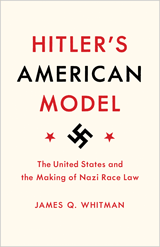Book cited at.
 |
Hitler's American Model:
|
How American race law provided a blueprint for Nazi Germany
Nazism triumphed in Germany during the high era of Jim Crow laws in the United States. Did the American regime of racial oppression in any way inspire the Nazis? The unsettling answer is yes. In Hitler's American Model, James Whitman presents a detailed investigation of the American impact on the notorious Nuremberg Laws, the centerpiece anti-Jewish legislation of the Nazi regime. Contrary to those who have insisted that there was no meaningful connection between American and German racial repression, Whitman demonstrates that the Nazis took a real, sustained, significant, and revealing interest in American race policies.
As Whitman shows, the Nuremberg Laws were crafted in an atmosphere of considerable attention to the precedents American race laws had to offer. German praise for American practices, already found in Hitler's Mein Kampf, was continuous throughout the early 1930s, and the most radical Nazi lawyers were eager advocates of the use of American models. But while Jim Crow segregation was one aspect of American law that appealed to Nazi radicals, it was not the most consequential one. Rather, both American citizenship and antimiscegenation laws proved directly relevant to the two principal Nuremberg Laws—the Citizenship Law and the Blood Law. Whitman looks at the ultimate, ugly irony that when Nazis rejected American practices, it was sometimes not because they found them too enlightened, but too harsh.
Indelibly linking American race laws to the shaping of Nazi policies in Germany, Hitler's American Model upends understandings of America's influence on racist practices in the wider world.
James Q. Whitman is the Ford Foundation Professor of Comparative and Foreign Law at Yale Law School. His books include Harsh Justice, The Origins of Reasonable Doubt, and The Verdict of Battle. He lives in New York City.
"A small book, but powerful all out of proportion to its size in exposing a shameful history."--Kirkus
"Interesting and eye opening. . . . In spite of the Nazis’ disdain, to put it mildly, for our stated and evident liberal and democratic principles, they eagerly looked to the United States as the prime example for their own goals of protecting the blood, restricting citizenship, and banning mixed marriages. Reading this book could make many Americans doubt the possibility of ever forming a more perfect union with such a legacy."--Thomas McClung, New York Journal of Books
“The admiration for American immigration policy expressed in Mein Kampf was not a passing thought on the day’s news . . . Nor a one-off remark. Its place in the full context of Nazi theory and practice comes into view in Hitler’s American Model. . . . Many people will take the very title as an affront. But it’s the historical reality the book discloses that proves much harder to digest. The author does not seem prone to sensationalism. The argument is made in two succinct, cogent and copiously documented chapters, prefaced and followed with remarks that remain within the cooler temperatures of expressed opinion."--Scott McLemee, InsideHigherEd.com
"Stunningly well-timed."--Tim Stanley, Daily Telegraph
TABLE OF CONTENTS:
A Note on Translations ix
Introduction 1 1 Making Nazi Flags and Nazi Citizens 17 The First Nuremberg Law: Of New York Jews and Nazi Flags 19 The Second Nuremberg Law: Making Nazi Citizens 29 America: The Global Leader in Racist Immigration Law 34 American Second-Class Citizenship 37 The Nazis Pick Up the Thread 43 Toward the Citizenship Law: Nazi Politics in the Early 1930s 48 The Nazis Look to American Second-Class Citizenship 59 Conclusion 69 2 Protecting Nazi Blood and Nazi Honor 73 Toward the Blood Law: Battles in the Streets and the Ministries 81 Battles in the Streets: The Call for "Unambiguous Laws" 81 Battles in the Ministries: The Prussian Memorandum and the American Example 83 Conservative Juristic Resistance: Gürtner and Lösener 87 The Meeting of June 5, 1934 93 The Sources of Nazi Knowledge of American Law 113 Evaluating American Influence 124 Defining "Mongrels": The One-Drop Rule and the Limits of American Influence 127 Conclusion 132 America through Nazi Eyes 132 America's Place in the Global History of Racism 137 Nazism and American Legal Culture 146 Acknowledgments 163 Notes 165 Suggestions for Further Reading 197 Index 201
***
See also: Hitler believed his new Europe would challenge the United States by imitating it:--from |
No comments:
Post a Comment